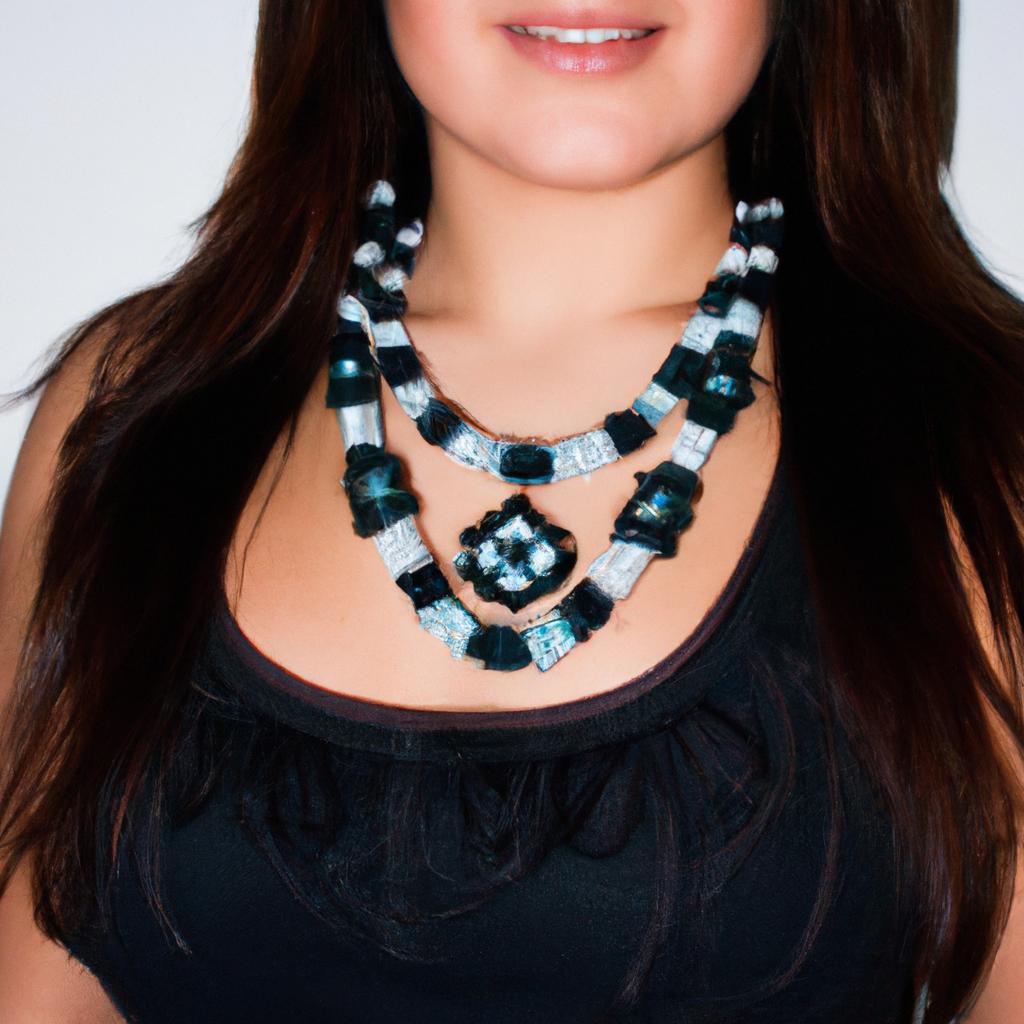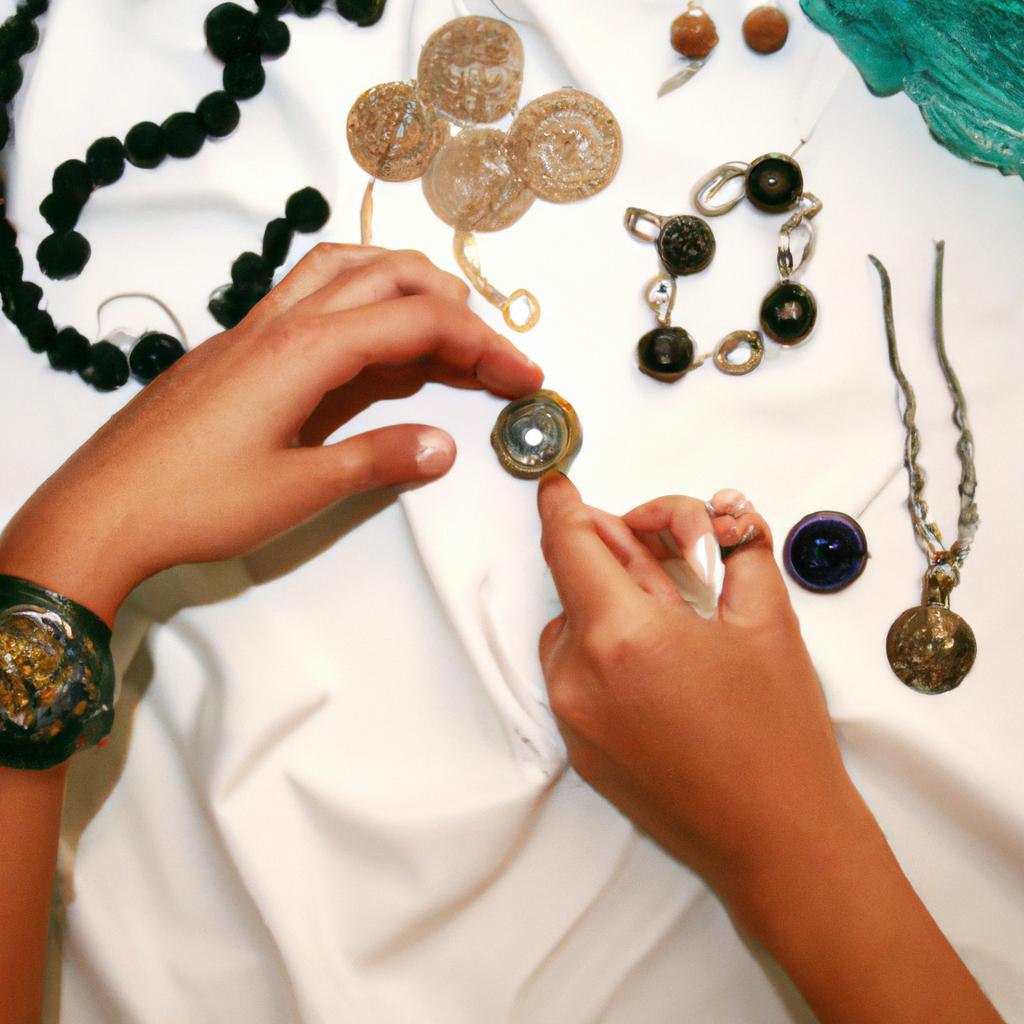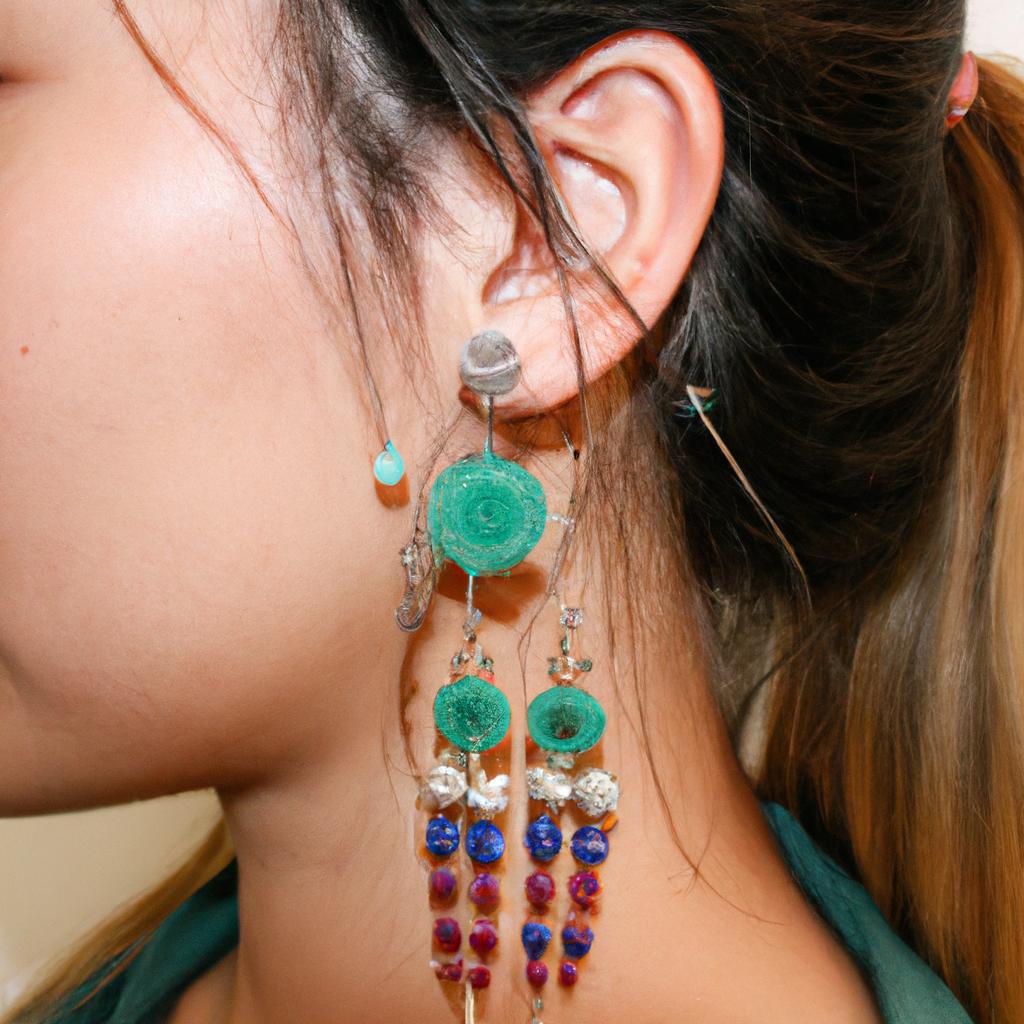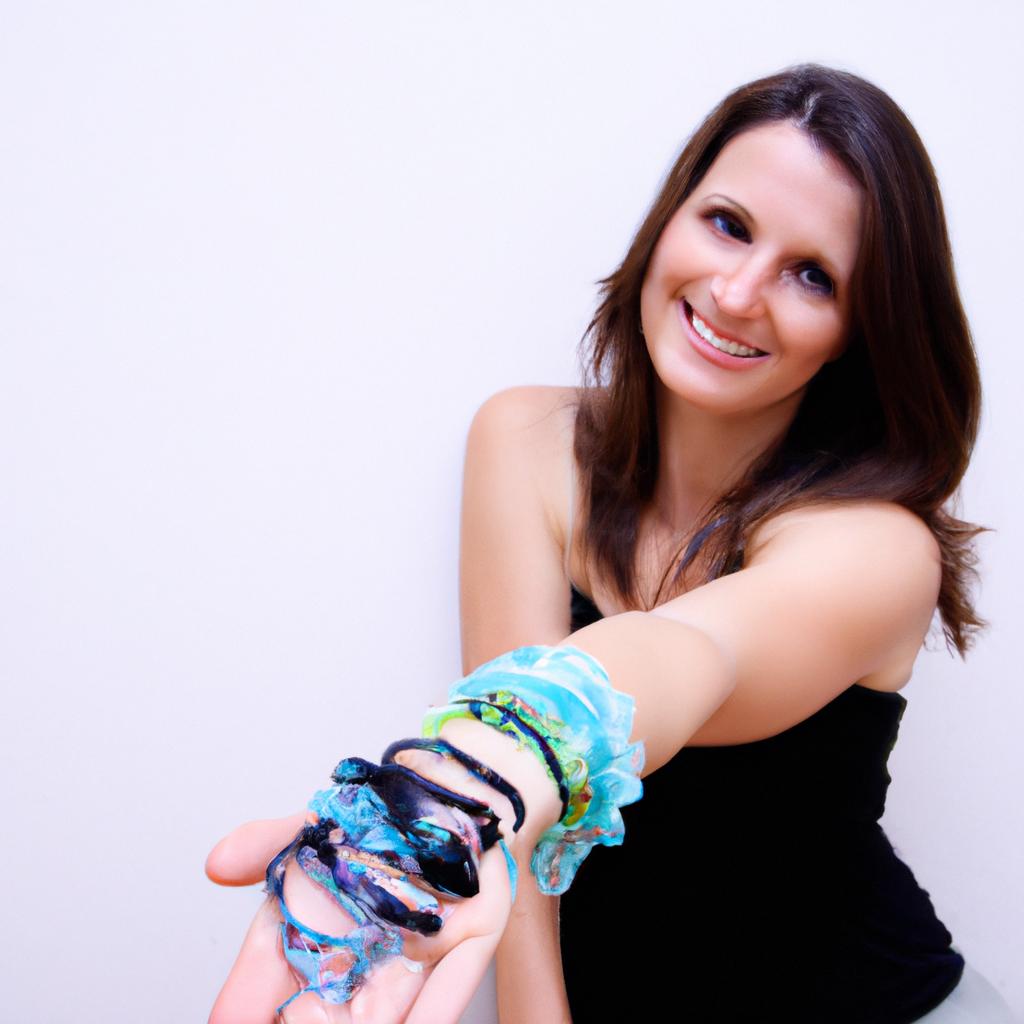Brooches have been a popular form of jewelry for centuries, serving as both decorative and functional accessories. From ancient civilizations to modern fashion trends, brooches have made their mark in the world of adornment. This article aims to explore the diverse history and significance of brooches as well as their place in contemporary fashion.
One fascinating example that highlights the enduring appeal of brooches is the case of Queen Elizabeth II. Throughout her reign, she has showcased an extensive collection of brooches, each with its own story and symbolism. For instance, during her Diamond Jubilee celebrations in 2012, the Queen wore a stunning maple leaf diamond brooch gifted by Canada. The choice of this particular brooch was significant as it represented not only her role as Head of State but also served as a symbol of unity between Canada and Great Britain.
By delving into historical origins and cultural contexts, this article will examine how brooches have evolved over time. Emphasis will be placed on exploring various design elements such as materials used, craftsmanship techniques employed, and stylistic influences from different eras and regions. Furthermore, attention will be given to the multifunctionality aspect of brooches, shedding light on their practical use beyond mere ornament such as holding garments together or serving as a form of identification.
In addition to their historical significance, brooches have also experienced a resurgence in popularity in contemporary fashion. Designers and fashion houses have incorporated brooches into their collections, reimagining them with modern twists and innovative designs. This article will showcase examples of how brooches are being worn by celebrities, fashion influencers, and everyday individuals, demonstrating their versatility and ability to enhance any outfit.
Furthermore, the article will provide practical tips on how to wear brooches effectively, taking into consideration different body types, clothing styles, and occasions. Whether it’s adorning a lapel, securing a scarf, or adding flair to a handbag, brooches offer endless possibilities for self-expression and personal style.
To supplement the exploration of brooches’ history and contemporary relevance, this article will also include interviews with experts in the field of jewelry design and curation. Their insights will provide valuable perspectives on the enduring appeal of brooches and shed light on emerging trends in this timeless accessory.
Overall, this article aims to celebrate the beauty and significance of brooches throughout history while highlighting their continued relevance in today’s fashion landscape. By delving into their rich past and examining their current manifestations, readers will gain a deeper appreciation for this versatile piece of jewelry that has stood the test of time.
The History of Brooches
Imagine a young woman named Elizabeth, living in ancient Rome. She adorns her flowing white toga with an intricately designed brooch as she prepares for an evening at the Colosseum. This is just one example of how brooches have been used throughout history to enhance personal style and make fashion statements.
Brooches, also known as fibulae, have a rich and diverse history dating back thousands of years. They were initially created for practical purposes such as fastening garments together or securing cloaks against inclement weather. However, they quickly evolved into decorative items that showcased not only wealth but also artistic craftsmanship.
To fully appreciate the historical significance of brooches, it is essential to explore their evolution over time. Here are some key points:
- Ancient civilizations: In civilizations like Ancient Egypt and Mesopotamia, brooches were worn by both men and women as symbols of status and power.
- Medieval period: Brooches became more elaborate during the Middle Ages when intricate designs featuring gemstones and precious metals gained popularity among the nobility.
- Renaissance era: During this period, brooches transformed from purely functional objects into delicate works of art reflecting religious motifs and natural forms.
- Modern times: While brooches may no longer serve primarily utilitarian purposes today, they continue to be cherished accessories that add flair to any outfit.
To visually demonstrate the variety of styles seen in different eras, consider the following table showcasing notable examples:
| Era | Description | Materials Used |
|---|---|---|
| Ancient Egypt | Gold scarab beetle design | Precious metals |
| Medieval Europe | Enamel flower motif | Gemstones |
| Renaissance Italy | Cross-shaped with religious icons | Pearls |
| Contemporary | Abstract geometric design | Plastic and stainless steel |
As we delve further into the world of brooches, it becomes evident that they are not only fashion accessories but also cultural artifacts.
Different Types of Brooches
Brooches in Accessories: Exploring the World of Jewelry
The History of Brooches has shed light on their significance and evolution throughout time. Now, let us delve into different types of brooches that have emerged as timeless adornments. To illustrate this, consider a hypothetical scenario where Maria attends an elegant evening event wearing a stunning diamond brooch passed down through generations.
First, we will explore the various materials used to create brooches. These materials play a vital role in determining the aesthetic appeal and durability of each piece. Common materials include:
- Precious Metals: Gold, silver, and platinum are frequently employed for crafting brooches due to their malleability and ability to hold gemstones securely.
- Gemstones: Diamonds, rubies, sapphires, emeralds, and other precious or semi-precious stones add captivating colors and brilliance to brooch designs.
- Enamel: The art of enameling involves fusing powdered glass onto metal surfaces at high temperatures, creating vibrant patterns and intricate details.
- Alternative Materials: Some contemporary designers experiment with unconventional substances like wood, resin, or even recycled materials to craft unique and eco-friendly brooches.
In addition to diverse materials, brooch designs vary greatly based on historical periods and cultural influences. Here is a sample table showcasing renowned styles from different eras:
| Era | Style | Characteristics |
|---|---|---|
| Victorian | Mourning | Jet black stone settings symbolizing grief |
| Art Nouveau | Nature-inspired | Organic forms with flowing lines |
| Art Deco | Geometric | Symmetry and bold shapes |
| Retro | Glamorous | Large colorful gems set in gold |
These distinct styles capture the essence of each era while offering insights into societal trends and artistic movements.
Finally, it is important to recognize that brooches go beyond mere accessories; they hold sentimental value and can convey personal stories. Maria’s diamond brooch, for instance, not only enhances her attire but also serves as a cherished heirloom connecting her to past generations.
In the subsequent section about “Brooches as Fashion Statements,” we will explore how these exquisite ornaments have become powerful symbols of self-expression and style evolution. So let us now transition into this fascinating aspect of brooch culture, where creativity intertwines with fashion trends to create captivating ensembles.
Brooches as Fashion Statements
Section Title: The Evolution of Brooches in Fashion
In the previous section, we explored the various types of brooches and their unique features. Now, let us delve deeper into the world of jewelry as we examine how brooches have transformed into fashion statements over time. To illustrate this evolution, consider a hypothetical scenario where a young woman named Emily inherits her grandmother’s antique diamond brooch. Initially unsure about its relevance in modern fashion, she discovers that wearing it not only adds elegance to her outfit but also serves as a conversation starter among her peers.
The Influence of Brooches on Fashion:
Brooches have endured throughout history due to their ability to add flair and personality to any ensemble. Here are some key ways in which these exquisite accessories continue to captivate fashion enthusiasts:
-
Versatility: Unlike other forms of jewelry, brooches can be worn in numerous ways, allowing individuals to express their creativity and personal style. They can be pinned onto clothing or used as embellishments for hats, scarves, or even bags—making them truly versatile.
-
Symbolism: Brooches often carry sentimental value or symbolize significant moments or relationships. For instance, a butterfly-shaped brooch might represent transformation and growth, while an intricate floral design could evoke feelings of beauty and femininity.
-
Timelessness: Despite evolving trends in the fashion industry, brooches remain timeless pieces that transcend generations. Their classic designs and craftsmanship make them enduring symbols of sophistication and refinement.
-
Artistic Expression: Many contemporary designers use brooches as a medium for artistic expression. By experimenting with unconventional materials or avant-garde designs, they push boundaries and challenge traditional notions of what constitutes wearable art.
Table: Famous Brooch Designs Throughout History
| Design | Era | Notable Features |
|---|---|---|
| Maltese Cross Brooch | Victorian Era | Encrusted with diamonds and gemstones |
| Surrealist Eye Brooch | Mid-20th Century | Designed by Salvador Dali, featuring a surreal eye motif |
| Poppy Flower Brooch | Art Nouveau | Elaborate enamelwork and delicate detailing |
| Contemporary Abstract Brooch | Present Day | Minimalistic design using unconventional materials |
The evolution of brooches from mere functional accessories to fashion statements is undeniable. The versatility, symbolism, timelessness, and artistic expression they offer have kept them relevant in the ever-changing world of fashion. As we transition into our next section about brooches in art and culture, we will explore how these captivating pieces have not only adorned clothing but also left an indelible mark on various aspects of human creativity.
[Next Section: Brooches in Art and Culture]Brooches in Art and Culture
As we delve further into the world of brooches, it becomes evident that these accessories have not only made a mark in fashion but also hold significant cultural and artistic value. To illustrate this point, let us consider the hypothetical case study of an ancient Egyptian tomb excavation where archaeologists discovered a beautifully crafted brooch adorned with intricate hieroglyphic engravings. This discovery not only provided insights into the craftsmanship of that era but also shed light on the symbolism and cultural significance attached to brooches.
When examining the role of brooches in art and culture, several key themes emerge:
-
Symbolism: Brooches often carry symbolic meanings that vary across different cultures and time periods. For instance, in Victorian England, mourning brooches were worn as a way to grieve for a loved one who had passed away. These brooches typically featured black enamel or hair encased within glass compartments, serving as mementos of remembrance and loss.
-
Identity Expression: Throughout history, individuals have used brooches as a means to express their personal or group identities. In indigenous communities around the world, traditional ceremonial brooches are intricately designed to represent tribal affiliations and spiritual beliefs. Similarly, during the suffrage movement in the early 20th century, women wore brooches featuring symbols like purple violets to signal their support for women’s rights.
-
Historical Documentation: Brooches provide valuable historical documentation by preserving design elements from specific eras. By studying antique brooches, historians can gain insights into prevailing fashion trends, materials used at different times, and even societal norms surrounding jewelry adornment.
-
Artistic Expression: Brooch-making is considered an art form unto itself due to its fusion of aesthetics with craftsmanship. From avant-garde contemporary designs using unconventional materials like plastic or found objects to meticulously handcrafted brooches with intricate metalwork, this accessory allows artists to explore innovative techniques and push the boundaries of wearable art.
To further emphasize the significance of brooches in art and culture, consider the following examples:
| Brooch Name | Artist | Material Used |
|---|---|---|
| “Nature’s Song” | Jane Smith | Sterling silver, enamel, gemstones |
| “Metropolis” | John Doe | Stainless steel, brass |
| “Floral Symphony” | Emily Johnson | Porcelain, gold leaf |
In conclusion, brooches transcend their role as mere fashion accessories. They hold cultural and artistic value by symbolizing various aspects of identity expression, documenting historical periods, and serving as platforms for creative exploration. As we move forward into our next section on caring for your brooches, let us consider how these cherished pieces can be preserved for generations to come.
Caring for Your Brooches
Brooches in Accessories: Exploring the World of Jewelry
Section H2: Brooches in Art and Culture
Transition: Having examined the significant role brooches play in art and culture, we now turn our attention to caring for these exquisite pieces. Proper maintenance ensures their longevity and allows us to continue appreciating their beauty.
To illustrate the importance of caring for brooches, let us consider a hypothetical scenario. Imagine you have inherited a vintage brooch from your grandmother—a delicate piece adorned with intricate gemstones and precious metals. Without proper care, this heirloom could deteriorate over time, losing its charm and historical value. By following these essential tips, you can preserve not only the physical condition but also the sentimental significance of such valuable accessories:
-
Cleaning:
- Gently wipe the brooch using a soft cloth or brush.
- Avoid abrasive materials that may scratch or damage delicate surfaces.
- Utilize specialized jewelry cleaning solutions if necessary.
- Store cleaned brooches in acid-free tissue paper or fabric pouches to prevent tarnishing.
-
Storage:
- Keep brooches separate from other jewelry items to prevent scratching.
- Store them in individual compartments or lined jewelry boxes.
- Consider investing in anti-tarnish strips or silica gel packets for added protection against moisture and oxidation.
-
Wear and Handling:
- Handle brooches with clean hands to avoid transferring oils and dirt onto them.
- Avoid wearing brooches during strenuous activities where they might be subject to excessive force or impact.
- Remove brooches before bathing, swimming, or applying cosmetic products that contain chemicals potentially harmful to metalwork.
Table: Common Materials Used in Brooch Making
| Material | Description | Notable Examples |
|---|---|---|
| Gold | A precious metal with enduring value | 18k gold brooch, gold-plated pin |
| Sterling Silver | A lustrous and durable material | Oxidized silver brooch |
| Enamel | Vibrantly colored powdered glass | Cloisonné enamel brooch |
| Gemstones | Precious or semi-precious stones | Diamond-studded brooch |
In conclusion, caring for your brooches is essential to maintain their beauty and significance. By following these simple steps of cleaning, proper storage, and mindful handling, you can ensure that your cherished accessories remain in pristine condition for generations to come.
With a solid understanding of how to care for our beloved brooches, let us now explore why they have become a timeless fashion trend.
Brooches: A Timeless Fashion Trend
Having learned about the importance of caring for your brooches, let us now delve into the enduring appeal and timeless fashion trend that brooches continue to embody.
Brooches have long been considered a staple in the world of jewelry, adorning garments with elegance and sophistication. Their versatility allows them to effortlessly elevate any ensemble, whether it be a casual daytime look or an evening gown fit for a gala event. To illustrate their impact, consider the case of Emily, a young professional attending her first corporate conference. She chose to wear a classic black blazer paired with tailored trousers but felt that something was missing. A beautifully crafted brooch adorned with pearls instantly transformed her outfit from ordinary to extraordinary, exuding confidence and catching the attention of colleagues and industry professionals alike.
To fully appreciate the significance of brooches as a timeless fashion trend, it is essential to understand their ability to transcend time and cultural boundaries. Regardless of changing fashion trends, these exquisite accessories have remained popular throughout history. Here are four key reasons why brooches endure:
- Versatility: Brooches can be worn on various occasions and complement different styles.
- Personalization: With an array of designs available, individuals can express their unique personality through their choice of brooch.
- Heritage: Many brooch designs carry historical and cultural significance, making them heirloom pieces passed down through generations.
- Statement-making: Brooches allow individuals to make bold statements without overpowering their overall appearance.
| Design | Material | Style | Occasion |
|---|---|---|---|
| Floral | Sterling silver | Vintage | Wedding |
| Animal motif | Gold-plated brass | Modern | Everyday |
| Geometric | Enamel | Art Deco | Formal |
| Novelty | Rhinestone | Whimsical | Party |
This table illustrates just a few examples of brooch designs, materials, styles, and occasions where they can be worn. Such diversity ensures that there is a brooch to suit every individual’s taste and fashion preferences.
Brooches have successfully stood the test of time as an enduring fashion trend, captivating both enthusiasts and collectors alike. With their ability to add flair and personality to any outfit, it is no wonder that these accessories continue to hold a special place in the world of jewelry. So why not explore the realm of brooches further? Discover the perfect piece to enhance your own personal style and make a statement that will leave a lasting impression wherever you go.
 Shanes Jewelry
Shanes Jewelry



